 MUSEUM OF FLIGHTSIMULATION, Someren (the Netherlands)
MUSEUM OF FLIGHTSIMULATION, Someren (the Netherlands)
Can you believe that a flightsim-fanatic like
me has lived near a flightsimulation museum for 14 years, and only found
out about it a few months ago? Well I couldn't! So I had to go over there
in a hurry!
The first time I went to visit I was very impressed. It
was much better than what I had expected it to be. Some old and some newer
simulators, and all in perfect condition. The people that worked there
were the dedicated hobbyist-like. We were given a great tour, and I just
started to love this museum. What's even better: after I told the man that
was giving us the tour, that I was working on my own F16-cockpit, he looked
through his archive and GAVE me detailed drawings of the F16-outer body,
and a book of the F16 "FalconStar" simulator, FOR KEEPS!! This called for
some extra exposure for the museum, and a story about the museum on the
SimPits website....
The Museum of Flightsimulation is run by a foundation
called "Stichting De Link". This foundation was founded in 1986 by three
men with a common hobby: Leo van der Weerden, Arnold van Genesen and Charles
Bergefurt. As the 'foundation' suggests it is a nonprofit organization,
with a number of goals:
1. Preserving old and new simulators
2. Restoring and maintaining simulators (both in and
outside the museum)
3. Getting people/visitors acquainted with aviation!
4. Acquire and supply information on simulation and
aircraft-types.
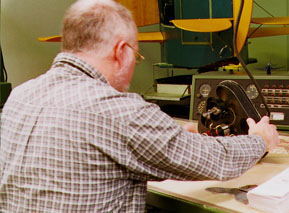 |
Leo van der Weerden, working
on a plotter-like device that draws the "flight" of a simulator onto a
map on the table. A very ingenious device that follows all the movements
according to the controls-input inside the simulator. |
 SIMULATORS CURRENTLY ON DISPLAY
SIMULATORS CURRENTLY ON DISPLAY
There are a number of simulators currently on
display in the museum. Some are in complete working condition, and others
are in work of progress.
| LINK D2 (ex- Royal
Air Force) |
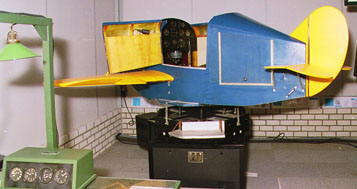 |
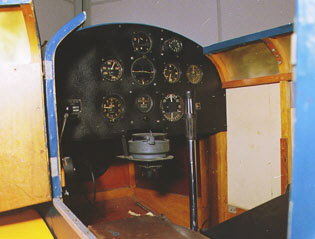
|
| This Link D2 trainer is the oldest simulator
currently in the museum. It was build in 1942 and thus served through the
better part of WW2. It is complete with a map-plotter and operator station.
Nice detail is that it is a simulator with actual wings. This as an extra
reference to the aircraft's "attitude". |
| LINK 1CA-1J <Link
C8 in civilian version> (ex-U.S.-NAVY) |
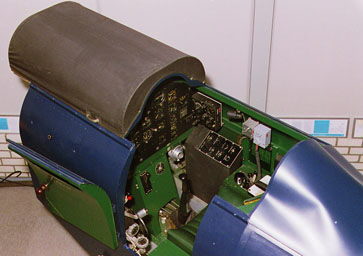 |
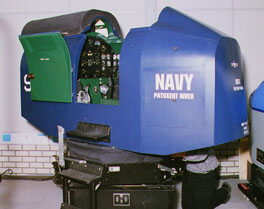
|
| This fully operational trainer is a 1950's
U.S.-NAVY simulator. A proud achievement of the museum, since it was almost
a complete wreck when they first acquired this model. This one also comes
with a complete operator-pilot setup. |
| Airtrainer LINK AT10 (ex-Rijksluchtvaartschool
KLM) |
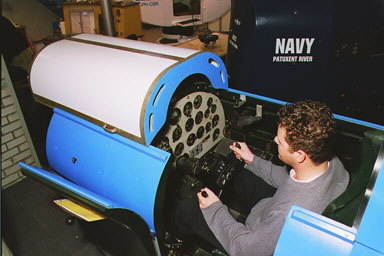 |

|
| The AT10 is also a fully operational
model. This one does not simulate the 'yaw' movement unlike the previous
two, but pitch and roll are simulated.
As seen in the second picture, communications are through
a radio setup. This is especially useful when the cockpit becomes totally
enclosed. Arnold van Genesen giving some directions to a 'wannabee' pilot
here... ;-) |
| SINGER/LINK GAT <Cessna
Trainer> (ex-Rijksluchtvaartschool KLM) |
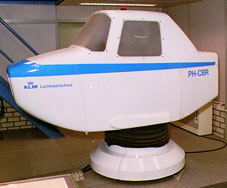
|
| Completely working trainer in excellent
condition. It is used to give (non-certified) flying lessons. It is possible
to make an appointment and get lessons. You pay a small fee, and you will
be educated on what YOU want to learn. |
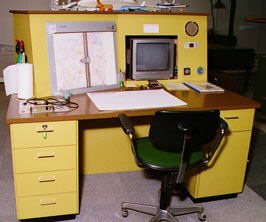
|
| Here you see the operator
station, with radio for communications, a flight-plotter and a backup instruments
display. The operator can change flight-conditions on the go. The monitor
on the right is connected to a camera inside the cockpit, situated behind
the "pilot". This way the operator can read the instruments real-time and
see all the actions of the trainee. |
| VISTA |
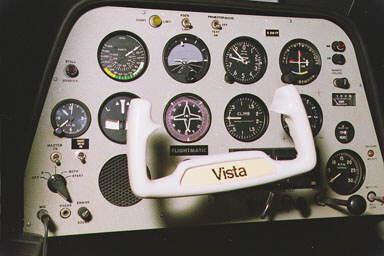 |
| The only sim in
the museum that has a visual display. Don't expect state of the art high-res
graphics though. They made use of a sort of 'endless-picture'. You don't
get changes in height or position (you don't come closer to the mountains
depicted). What you do get, is a visual sense of attitude and turnrate
of the aircraft. Unfortunately I do not have a picture of the actual graphics. |
| ATC Helicopter Simulator |
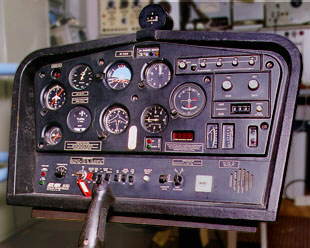 |
| The only helicopter simulator
in the museum. It doesn't have an outer body so it's not enclosed. It's
an instrument trainer that's basically a seat, an instrument panel and
a complete controls-setup with collective, stick and rudder pedals. As
seen on this picture, it is also in mint condition. |
| FRASCA 100 (ex-Frasca
factory) |
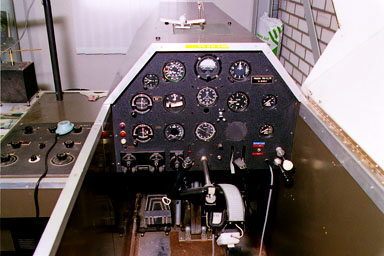 |
| A pretty old and apparently
'angular' design, with the ability to be totally enclosed. |
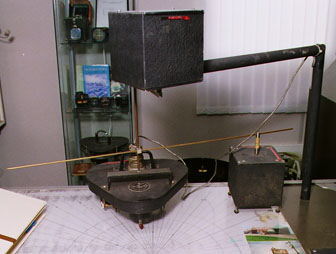 |
| This is the plotter of the
Frasca 100 simulator which draws the flightpath onto a map placed on the
table. |
| FRASCA 210 <Turboprop
"twin"-simulator> (ex-Selkirk College Vancouver) |
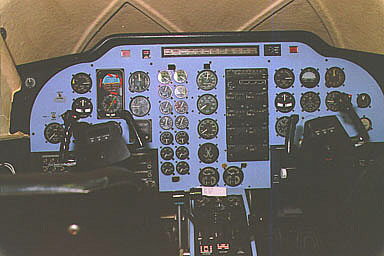 |
| An absolute masterpiece. The
only 'two-person' simulator in the museum, and definitely a very beautiful
one. A look 'under the hood' revealed a work of art that challenges most
handcrafted clockworks! It is a nonmoving simulator. |
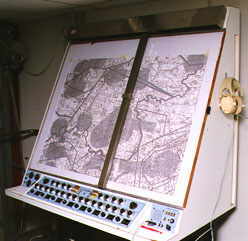 |
| The plotter that comes with
the Frasca 210. |
Most of the simulators in the museum are actually operational.
The moving ones are working on a ball-joint principle in the middle. The
older simulators are operated by vacuum-bellows, and the newer ones by
electronic/mechanical means. The movement is based on the attitude of the
simulated aircraft and not on 'sensory-inputs' like many modern ones. This
means there is also no washout, but the simulator 'holds' the same position
as a real aircraft would in flight. Washout does happen though, but it
is by your own sensory adaptation that you loose the feeling of being 'tilted'.
Al the instruments work as they would in a real airplane. The compass is
an actual compass indeed. It is not electronically driven, but driven by
the earths magnetic feel.
Most simulators in the museum, have an operator/pilot
setup. Which means that there is an operator outside the cockpit that directs
the flight. He tells the pilot what to do and where to go. The operator
has a set of 'back-up' instruments, so he can see what's happening with
the plane all the time. The operator and pilot communicate through a radio,
microphone and earphones. The operator can also change flight-conditions
real-time and in-flight!
 FLYING THE BIRD
FLYING THE BIRD
To put it all to the test, I decided to make an appointment
for some "simulated flying lessons". Wednesday evening at 19:00h I was
ready for take off. First I got a quite detailed explanation on which factors
influence the performance of an aircraft, and how these factors were simulated.
I mean things like temperature, air pressure, turbulence, how air pressure
differs over sea and over land, loadout of the plane etc, and how all these
factors cross-influenced eachother. Some really complicated but revealing
stuff!! It was time for some coffee to let the stuff sink in a bit.
After the coffee, I was directed to the GAT "Cessna trainer"
and I entered a bit nervously. Here I was, sitting in a "real" simulator
with all switches, gauges, controls and handles working. Arnold van Genesen
was the one to instruct me on the basics. Through his explanation I started
to become really amazed at how extensive the possibilities of this simulator
were. He could externally change air pressure, temperature, weight, fuel-load
etceteras, and the meters in the cockpit would change their indications
accordingly!! Really amazing.
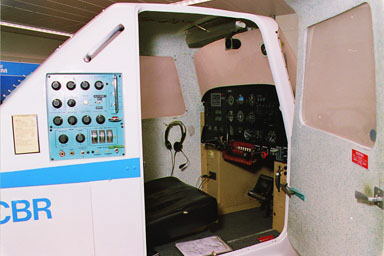
He continued about the basics of flying, and explained
a bit about the different gauges and switches. He told me how to adjust
the air-pressure setting in the altimeter, how to work the trim-wheel,
where and when to operate the gear and so on. Next up was a first lesson
on how to fly to and from a radio-beacon. I learned how to select the right
beacon, check the Morse-code and then fly to the beacon using instruments.
Rate 1(or 2-minute) turns were up next. And a challenge
it was to me! Really no easy task to complete your 360 degree turns in
2 minutes the first time (and the next 5 times weren't that easy either
;-) After an approach to the airfield I was ready for my first "solo"...
Doors closed and positioned on the 'westbound' runway
in Eindhoven, I got ready for take off. Power up, release the brakes, pull
up at about 60kts, at 200ft flaps and gear up and climbing steady to 2000ft.
Now on my own I really started to appreciate the complexity of instrument
navigation. Being a die-hard military-sim enthusiast, I'm used to focusing
on the HUD and visuals 'outside'. Now I was making mistakes like focusing
on one instrument and forgetting about the others. Making my '2 minute
turn' and forgetting about the heading I'm supposed to turn to. Focusing
on my airspeed and forgetting about my altitude, stuff like that. Focusing
on one instrument, it's real easy to loose the "big picture".
On my relatively uneventful flight, I had my hands full
just keeping the plane level and at the right heading. My blood, sweat
and tears were rewarded however, with a nice touchdown on the runway (or
at least that's what they told me! ;-)
 SIMULATOR MOVEMENT
SIMULATOR MOVEMENT
Although the movement is only related to the aircraft's
"attitude", and not to "sensory-inputs" like more complex and newer simulators,
I must say that the amount of feedback that you get from this is amazing.
You can really "feel" your turns. You know when you're going to steep and
when you're bound to get in trouble. What impressed me most, was the effect
of lowering the flaps. To "fight off" the increased lift generated by the
flaps, took quite some effort.
And then I'm not even talking about al the 'little' movement-cues,
that are not so explicit, but do complete the overall sensation of actual
flight!
Do I sound excited? That's because I am! This was really
one heck of an experience. Expect me to be a regular visitor to the museum.
It really sparked my interest in the more "civilian" flightsim experience!
And because SimpPits International was so kind to give them some extra
exposure here, I got my introductory lesson for free!!
If you are a flightsim enthusiast and live in the Netherlands
or close to it (not necessarily though ;-), this museum is a MUST visit.
If you go there ones, you will go there again. You can make an appointment
for a flight, and you can even go there with groups. For more information
check out this link: http://members.brabant.chello.nl/~c.vanlierop/stichtinglink.htm
My personal thanks go out to all of "Stichting De Link",
who were kind enough to provide me with all kinds of information regarding
the museum and other flight simulator-related stuff. Also for the exciting
introductory lesson. Special thanks go out to Paul Swinkels for taking
the excellent photo's. |